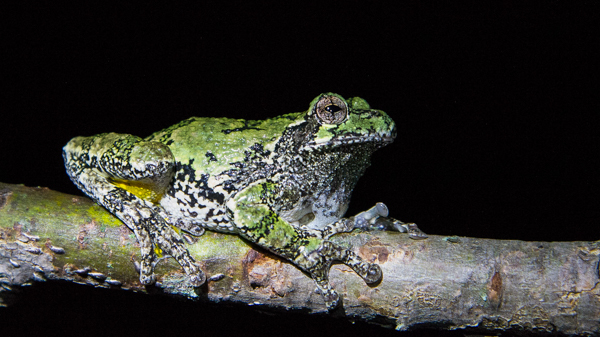"Pseudo-Nature" and Photographic Integrity

Guest blog written by 2015 Environmental Visual Communication student Sean de Francia
The 13th of June saw the fourth annual Ontario Bioblitz, a 24-hour frenzy of citizen science bringing taxonomic experts and ecological enthusiasts to the Don River Watershed to create an inventory of the local wildlife. This event is a great opportunity for scientists and the general public to gain insight into their local biodiversity.
As a budding photographer with a particular enthusiasm for charming amphibians, I found myself following a group of herpetologists (the Herp Dream Team, as they called themselves) through a number of field sites in search for Ontario’s 24 identified salamander, frog, and toad species (or perhaps even a surprise novel amphibian!)
The highlight of my Bioblitz experience was my encounter with a lone gray treefrog (Hyla versicolor) at the edge of a pond by the northern edge of the watershed. The frog species is highly arboreal, as its name suggests, and we thought it would make for an interesting photo if the frog was on a tree, giving it more “natural” appeal. We picked up the frog, carefully placed it on a nearby branch, and began snapping away.
I was really keen on capturing an action photo of the frog in mid-call, complete with the enlarged vocal sac. The process took quite a bit of patience requiring a series of trial and error shots - waiting to hear this frog’s call and hoping my camera’s settings were correct for that brief moment. It was around this time when a fellow Bioblitzer mentioned an increasingly common technique in wildlife photography involving the use of a recorded frog call to prompt my amphibian subject.

Techniques like using recorded calls to arouse animals is not a new phenomenon, but its increasing prevalence has led to an interesting discussion of photographic integrity - on the direct impact on the specimen in question, as well as how this impact is portrayed through the photos themselves. In this case, the issue at hand involved the physical rearrangement of the environmental composition, as well as the use of recorded calls to elicit a behavioural response from this frog.
The implications of a rearranged composition are rather straightforward: such intrusive staging of “nature” jeopardizes the legitimacy of the photo, and produces an obvious sense of displacement and disorientation in the subject (especially if it is not returned at the conclusion of the photoshoot). However, the consequences of such staging can extend beyond physical disruption. Exposing the treefrog to recorded calls changes its behaviour. This year’s Bioblitz fell within the gray treefrog’s expected mating season. During this time, the males from this species descend from their arboreal habitats to the shorelines of ponds and swamps to begin their chorus of mating calls. We would therefore expect that an adjacent call would arouse competition between these males, and perhaps evoke a greater, longer call from the stimulated individual. It is here that our ethics are called in to question: how will a recorded call affect the survival of this gray treefrog? Exposure to this sound stimulation, especially during its breeding season, creates a stressful environment where energy is reallocated to respond to these fake calls. This unnecessary energy expenditure could end up compromising the frog’s mating and foraging abilities, ultimately leading to a reduced ability to survive and find mates in the future.

Wildlife photography should not be an overly obtrusive process - the presence of a photographer alone can alter the environment, and taking extra measures to get that perfect shot may be too costly when you consider the greater ecological impact. Given the common purpose of ecological communication and conservation informing the intentions of many wildlife photographers, adherence to these ideals is both expected and necessary for the continued progression of this field.
A common ideal held by many wildlife enthusiasts can be summed up in the old motto of the Baltimore Grotto: “Take nothing but photographs, leave nothing but footprints”. Needless to say, I was not able to live up to this ideal in my pursuit of the perfect mating call photo.
In the end, I managed to capture my shot of the gray treefrog’s swollen vocal sac without the use of any recorded calls, and afterwards we returned the frog to the same spot in the pond where we initially found it. We continued our Bioblitz survey for the rest of the night, slightly more conscious of our impacts on the landscape.

